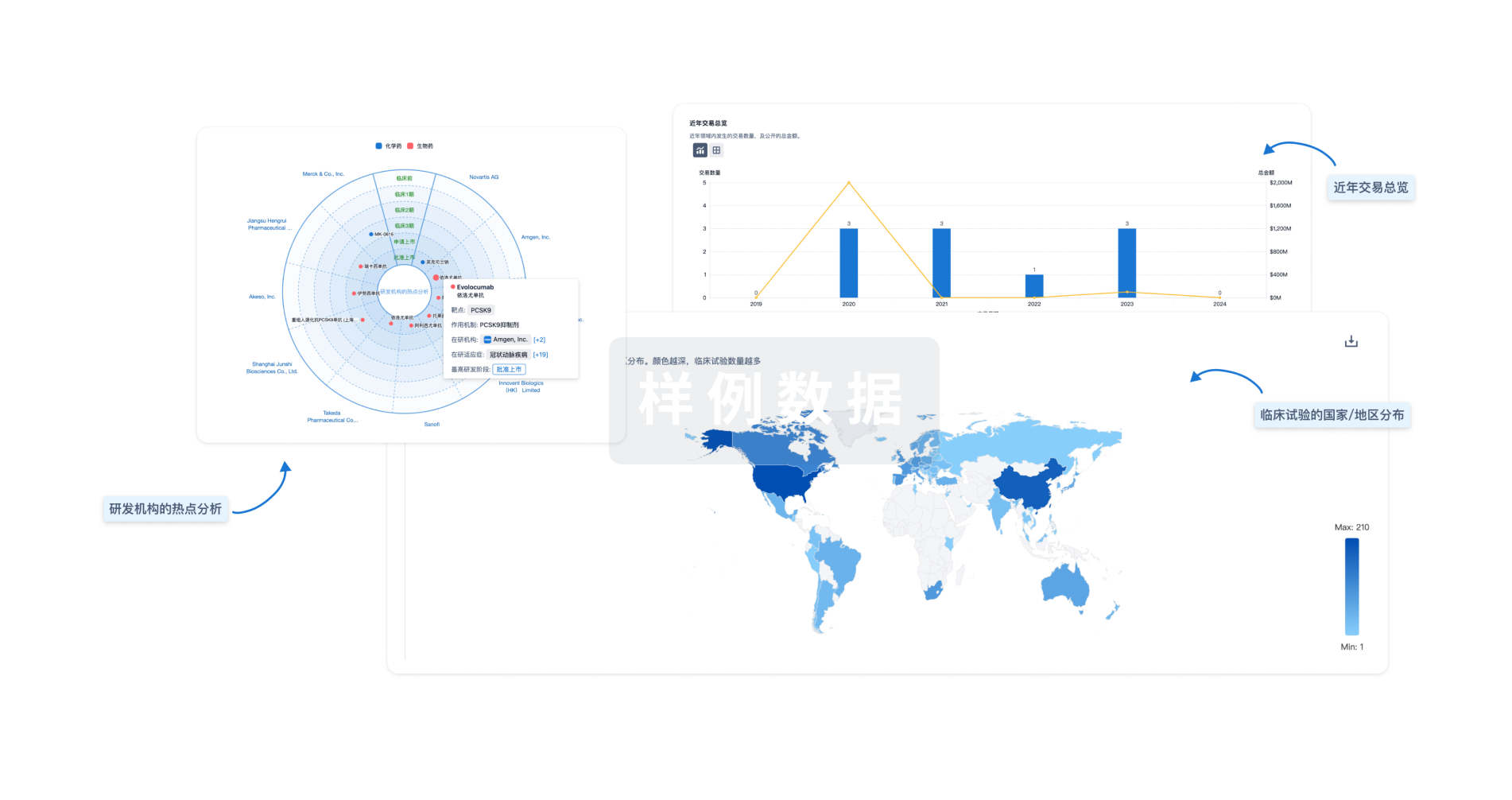预约演示
更新于:2025-05-07
COL8A1
更新于:2025-05-07
基本信息
别名 C3orf7、COL8A1、Collagen alpha-1(VIII) chain + [4] |
简介 Macromolecular component of the subendothelium. Major component of the Descemet's membrane (basement membrane) of corneal endothelial cells. Also a component of the endothelia of blood vessels. Necessary for migration and proliferation of vascular smooth muscle cells and thus, has a potential role in the maintenance of vessel wall integrity and structure, in particular in atherogenesis.
Vastatin, the C-terminal fragment comprising the NC1 domain, inhibits aortic endothelial cell proliferation and causes cell apoptosis. |
关联
100 项与 COL8A1 相关的临床结果
登录后查看更多信息
100 项与 COL8A1 相关的转化医学
登录后查看更多信息
0 项与 COL8A1 相关的专利(医药)
登录后查看更多信息
175
项与 COL8A1 相关的文献(医药)2025-07-01·Cellular Signalling
LPAR3 and COL8A1, as matrix stiffness-related biomarkers, promote nasopharyngeal carcinoma metastasis by triggering EMT and angiogenesis
Article
作者: Zhang, Kaiwen ; Wu, Rui ; You, Bo ; Gu, Miao ; Yi, Lu ; Zhang, Xin ; Xie, Haijing ; Xia, Tian ; You, Yiwen ; Yin, Haimeng ; Pan, Si
2025-04-01·Cell Reports Medicine
A spatially resolved transcriptome landscape during thyroid cancer progression
Article
作者: Li, Ling ; Wang, Yu ; Huang, Zhiheng ; Hu, Weiguo ; Wei, Wenjun ; Liao, Tian ; Zeng, Yu ; Ji, Qinghai ; Fung, Man Him Matrix ; Zhang, Yan ; Shi, Xiao ; Li, Shengli ; Shen, Cenkai ; Du, Yuxin ; Ding, Peipei ; Xu, Weibo ; Zhang, Meng
2025-02-24·JCI Insight
SPP1hi macrophages, NKG7 T cells, CCL5hi fibroblasts, and IgM plasma cells are dominant features of necrobiosis
Article
作者: Kuzminykh, Nikolay Yu ; Xing, Xianying ; Merleev, Alexander A ; Marella, Sahiti ; Kahlenberg, J Michelle ; Marusina, Alina I ; Li, Sophie Y ; Downing, Lauren ; Tsoi, Lam C ; Gompers, Andrea ; Gudjonsson, Johann E ; Harms, Paul W ; Maverakis, Emanual ; Liakos, William ; Le, Stephanie T ; Kunitsyn, Andrey ; Kruglinskaya, Olga ; Billi, Allison C ; Brüggen, Marie-Charlotte ; Kirane, Amanda ; Adamopoulos, Iannis E
1
项与 COL8A1 相关的新闻(医药)2025-01-01
·今日头条
【导读】
癌症相关成纤维细胞(CAFs)具有多种促肿瘤功能,是肿瘤耐药的关键因素。
12月28日,郑州大学第一附属医院与伦敦国王学院研究人员合作共同在期刊《Molecular Cancer》上发表了研究论文,题为“THBS2 + cancer-associated fibroblasts promote EMT leading to oxaliplatin resistance via COL8A1-mediated PI3K/AKT activation in colorectal cancer”,本研究发现THBS2在泛癌水平与CAF活化、上皮-间充质转化(EMT)和化疗耐药呈正相关。结合单细胞RNA测序和空间转录组学分析,研究人员确定THBS2特异性来源于CAFs亚群,称为THBS2 + CAFs,在CRC中,THBS2可以通过胶原通路与恶性细胞相互作用来促进奥沙利铂耐药性。机制上,THBS2 + CAFs特异性分泌的COL8A1与耐药恶性细胞上的ITGB1受体直接相互作用,激活PI3K-AKT信号通路,促进EMT,最终导致CRC对奥沙利铂耐药。此外,升高的COL8A1促进了EMT和CRC对奥沙利铂的耐药,这可以通过ITGB1敲低或AKT抑制剂减弱。
综上所述,这些结果表明了THBS2 + CAFs通过激活EMT在促进结直肠癌对奥沙利铂耐药中的关键作用,并为克服结直肠癌中奥沙利铂耐药的新策略提供了理论基础。
https://molecular-cancer.biomedcentral.com/articles/10.1186/s12943-024-02180-y#Sec16
背景信息
01
结直肠癌(CRC)是全球第三大常见癌症,每年新增病例超过 190 万例。除了手术干预外,化疗仍是结直肠癌治疗的重要手段,旨在缩小肿瘤并防止其未来生长和扩散。奥沙利铂是一种基于铂的化疗药物,在多种癌症的治疗中被广泛使用,尤其是结直肠癌、卵巢癌(OV)、胃癌(STAD)和胰腺癌(PAAD)。奥沙利铂与额外的化疗药物,如氟尿嘧啶和/或伊立替康,共同构成了 FOLFOX 或 FOLFIRINOX 方案,已被批准作为晚期和转移性结直肠癌的一线治疗方案。但是,基于奥沙利铂的化疗在结直肠癌的临床治疗中仍面临着严重的耐药性挑战。因此,找到有效克服这种耐药性的方法并提高治疗效果至关重要。
在肿瘤微环境(TME)中,各种细胞之间的相互作用对于癌症的发展至关重要。癌症相关成纤维细胞(CAFs)是 TME 的主要组成部分,是一群异质性的基质细胞,其来源、表型、功能和在不同癌症类型中的丰度各不相同。CAFs 对肿瘤的促进作用影响深远,并通过多种机制在耐药性中发挥关键作用,这凸显了其作为预后因素和治疗靶点的潜在价值。尤其是,与普遍认为 CAFs 总是促进肿瘤进展的观点相反,在胰腺导管腺癌(PAAD)和小鼠模型中,靶向 CAFs 的治疗已被证明会加重病情,这表明不同的 CAFs 亚群在疾病进展中可能发挥相反的作用。因此,要精确识别促进癌症的 CAFs 亚群,需要发现特定的生物标志物来区分 CAFs 亚群,并了解它们的活动和机制。近期的研究表明,在包括结直肠癌(CRC)在内的多种癌症类型中,癌相关成纤维细胞(CAFs)与恶性细胞之间的细胞间相互作用会导致化疗耐药性。然而,与结直肠癌中奥沙利铂耐药性相关的 CAFs 亚群的作用机制尚未完全阐明。
COL8A1 与 ITGB1 相互作用使奥沙利铂耐药
02
研究人员应用了 CellChat 程序来分析并识别特定的细胞间相互作用(CCI)。CCI 显示,THBS2 + CAFs 通过 COL8A1-ITGB1 与耐药恶性细胞的相互作用更多。空间转录组学(ST)显示,COL8A1 与 ITGB1 的共定位比与 ITGB8 的更多,因此 ITGB1 可能在通讯中发挥着尤为关键的作用。同时,ITGB1 在耐药细胞中高表达,与耐药细胞丰度、奥沙利铂曲线下面积(AUC)值以及 COL8A1 表达呈正相关,与奥沙利铂活性呈负相关,进一步表明 ITGB1 对耐药性可能具有潜在影响。值得注意的是,免疫组化(IHC)验证了 ITGB1 在无应答组中表达水平更高,表明 ITGB1 可能在耐药性中发挥着关键作用。
为了探究 COL8A1-ITGB1 的潜在相互作用能力,研究人员进行了分析以确认 COL8A1 与 ITGB1 之间的结合活性。结构可视化显示,氨基酸水平上的特定相互作用有助于 COL8A1-ITGB1 复合物的稳定性。研究结果共同表明 COL8A1-ITGB1 复合物具有强大的结合亲和力和结构完整性。此外,实验共免疫沉淀(Co-IP)证实 COL8A1 可直接与 ITGB1 相互作用,从而共同导致耐药性的产生。同样,SubMap 也显示 COL8A1-ITGB1 得分高的患者更有可能对化疗不敏感。为了实验验证该观察结果,研究人员对结直肠癌细胞进行体外培养,分别加入 COL8A1 或 siITGB1,结果表明 siITGB1 能够削弱 rhCOL8A1 促进奥沙利铂耐药的作用。在体内实验中,添加 siITGB1 能显著降低肿瘤体积和重量。此外,伤口愈合和迁移实验发现,结直肠癌细胞在接触 siITGB1 后迁移和侵袭能力下降。蛋白质印迹法证实,COL8A1 水平升高可上调 N-钙黏蛋白、SNAIL 和波形蛋白,下调 E-钙黏蛋白,而与 siITGB1 联合使用则降低了上皮间质转化标志物的水平。综上所述,这些结果表明 COL8A1 可通过 COL8A1-ITGB1 与恶性细胞直接相互作用,刺激恶性细胞获得对奥沙利铂的耐药性。
COL8A1 与 ITGB1 相互作用导致奥沙利铂耐药
研究还表明,COL8A1 与 ITGB1 直接相互作用可激活 PI3K-AKT 通路并促进上皮间质转化,从而导致结直肠癌对奥沙利铂产生耐药性。
结论
03
本研究揭示了THBS2 + CAFs在奥沙利铂耐药中的关键作用,并强调了其作为克服CRC中奥沙利铂耐药的预测性生物标志物和治疗靶点的潜力。
【参考资料】
https://molecular-cancer.biomedcentral.com/articles/10.1186/s12943-024-02180-y#Sec16
【关于投稿】
转化医学网(360zhyx.com)是转化医学核心门户,旨在推动基础研究、临床诊疗和产业的发展,核心内容涵盖组学、检验、免疫、肿瘤、心血管、糖尿病等。如您有最新的研究内容发表,欢迎联系我们进行免费报道(公众号菜单栏-在线客服联系),我们的理念:内容创造价值,转化铸就未来!
转化医学网(360zhyx.com)发布的文章旨在介绍前沿医学研究进展,不能作为治疗方案使用;如需获得健康指导,请至正规医院就诊。
热门推荐活动 点击免费报名
🕓 线上|2024年12月6日-2025年1月16日
▶ 《我的2024》
🕓 全国|2024年12月-2025年03月
▶ 中国转化医学产业大会
🕓 上海|2025年02月28日-03月01日
▶ 第四届长三角单细胞组学技术应用论坛暨空间组学前沿论坛
点击对应文字 查看详情
临床研究
分析
对领域进行一次全面的分析。
登录
或

Eureka LS:
全新生物医药AI Agent 覆盖科研全链路,让突破性发现快人一步
立即开始免费试用!
智慧芽新药情报库是智慧芽专为生命科学人士构建的基于AI的创新药情报平台,助您全方位提升您的研发与决策效率。
立即开始数据试用!
智慧芽新药库数据也通过智慧芽数据服务平台,以API或者数据包形式对外开放,助您更加充分利用智慧芽新药情报信息。
生物序列数据库
生物药研发创新
免费使用
化学结构数据库
小分子化药研发创新
免费使用